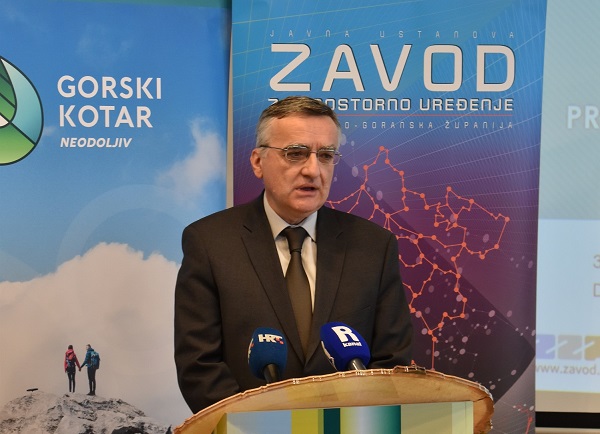Adam Butigan, Director of the Institute for Spatial Planning of Primorje-Gorski Kotar County, and Petar Hrg, Director of the Tourist Board of Gorski Kotar, gave the opening speeches at the workshop. The presentation was held by the leaders of the Study from the Institute for Spatial Planning of PGC Vana Rodin Kružić and Sanja Turk.
In order to contribute to the balanced development of Gorski Kotar, and based on the recognised features of the settlement’s typology, the Institute for Spatial Planning of Primorje-Gorski Kotar County initiated the study Spatial Identities of Rural Settlements in Gorski Kotar.

The initiative to deliberate how to prevent negative impacts on the visual identity of Gorski Kotar’s settlements came from the Tourist Board of Gorski Kotar. Namely, the Tourist Board pointed out to the Institute examples of buildings that deviate from the traditional types of construction in the area of Gorski Kotar. Based on the mentioned initiative, the Institute has assessed that the nature of the Tourist Board's request tends towards the need to preserve spatial identity. In accordance with this, the Study was designed to consider the possibilities of establishing spatial standards for the purpose of directing construction in valuable areas as well as in those where the spatial identity has been undermined.
With the preparation of the guidelines, which are the result of the research of this Study, the aim is to enrich and preserve the space and direct the design and construction of new buildings in the area of Gorski Kotar. The intention of this Study is to point out the existence of a construction tradition in the area of Gorski Kotar and to show the best way to preserve the tradition by using modern construction technology and modern materials. The aim of this Study is not to conserve the area of Gorski Kotar but to create the foundations for the future development of the typology based on Gorski Kotar’s roots, thereby affirming the spatial identity of the Gorski Kotar area.
In order to prepare the Study in a participatory and transparent manner, at the beginning of the preparation of the Study, a round table was held with heads and mayors who showed great interest in preserving the identity of the Gorski Kotar region. A workshop was held today with the general public, all in order to achieve the consensus of the profession and the public.
In its presentation, the Physical Planning Institute of PGC introduced the public to the definition of spatial identity. The identity of a space is determined by its spatial specificity and recognition. Spatial identity is a topic that is increasingly being discussed, including from various aspects, and it was positive that the initiative to start such a research/study came from the Tourist Board of Gorski Kotar because tourism plays an extremely important role in the transformation of the space in which it takes place. If the space is valorised in a systematic and interdisciplinary way, not omitting a single component, the Institute is of the opinion that the identity of the place will be preserved. The problem that appears is that by disrupting the original, traditional identity of the settlements, generic uniform spaces are created that do not encourage a sense of belonging to a place and that are not visually attractive.
Considering that the identity of a space is not formed by just one factor, it is necessary to consider the area of the settlement from different aspects with the aid of several types of indicators, so in the first block of the workshop, the public was encouraged to recognise which physical factors influence spatial identity. After the workshop and the discussion with the participants, the theoretical part explained the factors because they directly influence the transformation of the space and its identity.
In the second block of the workshop, those present needed to recognise the transformations of a settlement's identity using the example of pictures of houses in Gorski Kotar. It was necessary to divide the buildings into those that are typical houses in Gorski Kotar, and those whose construction types, building elements and spatial arrangement are not characteristic of Gorski Kotar. After the typical elements of a Gorski Kotar house and those that are not were explained using examples of pictures of houses, the transformations that influence the image of the settlement were explained to the participants.
In the third block of the workshop, those present were asked for their opinion about the ranking of transformations, they were specifically asked which transformations are personally the worst for them and which transformations they did not consider as transformations.
After the three interactive workshop blocks, Guidelines for the preservation of the spatial identity of the settlements, which are the result of the Study, were presented to the participants and a constructive discussion about them followed. The results of the workshop will be implemented in the Study.
The completed Study will be the basis for creating spatial plans for all 9 local self-government units of Gorski Kotar.
The publication, as well as all the promotional material related to the Study, will be publicly available, and in this way, future investors and the public will also be made aware of the value of the spatial identity of Gorski Kotar and the need to preserve it.